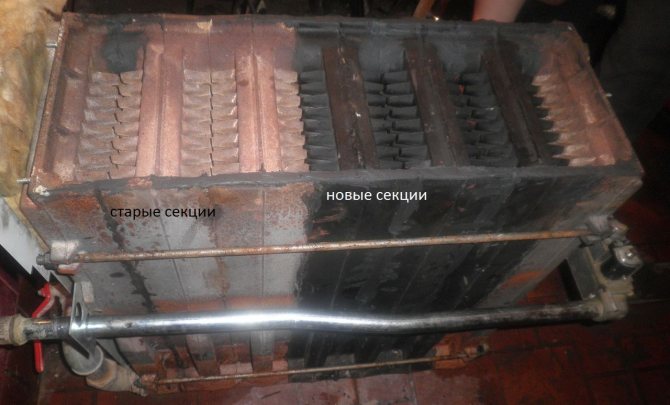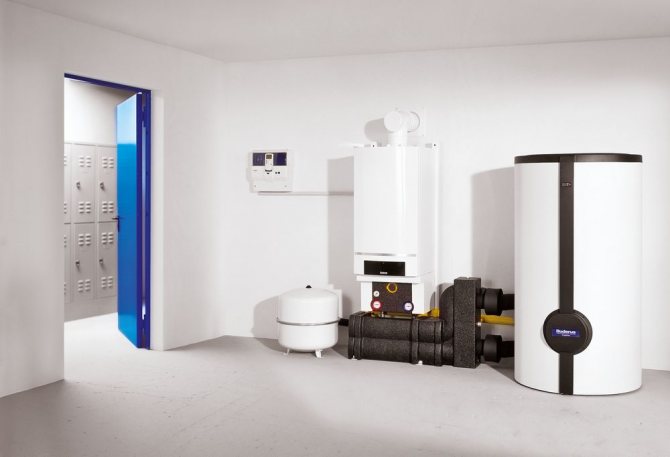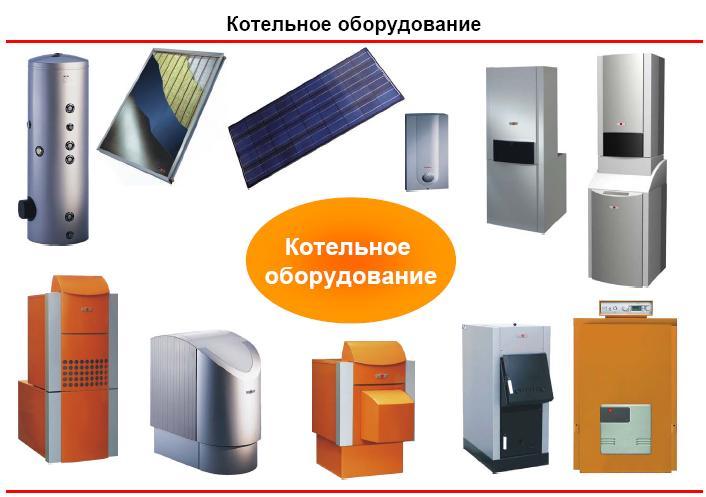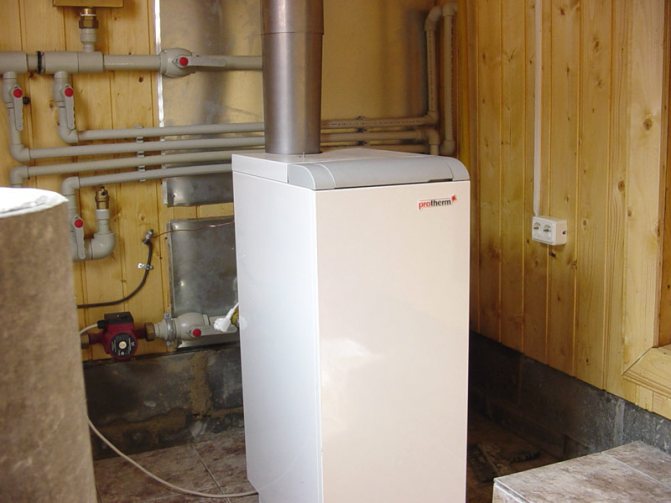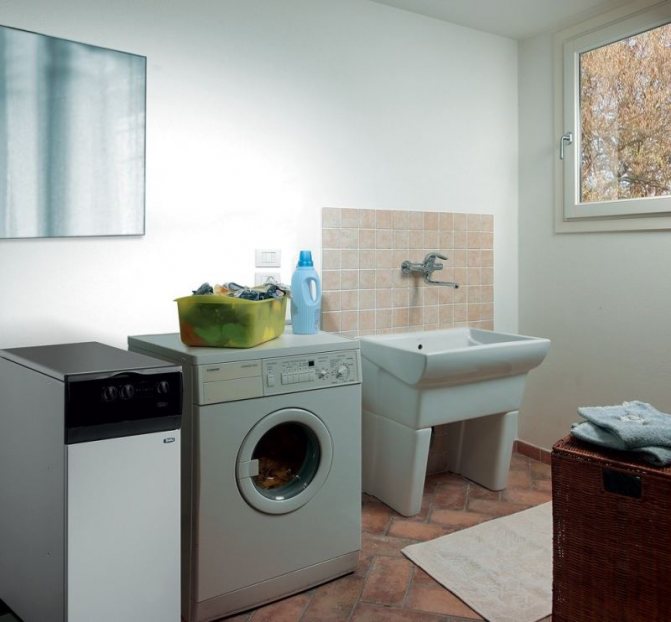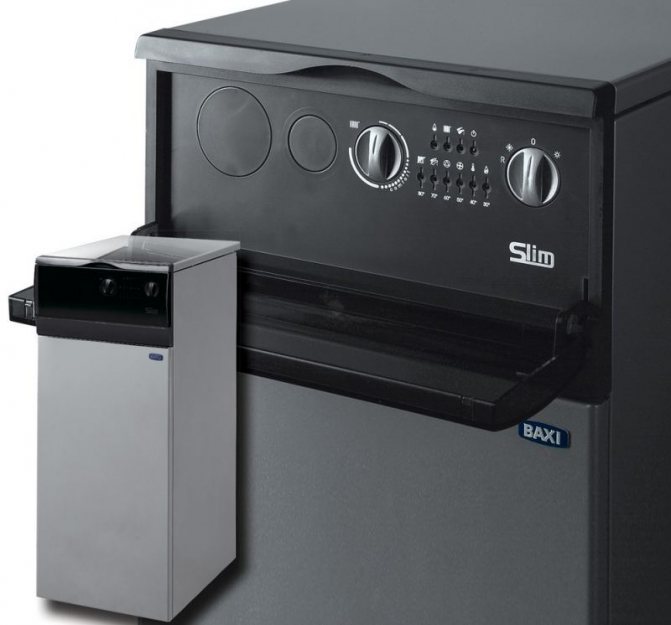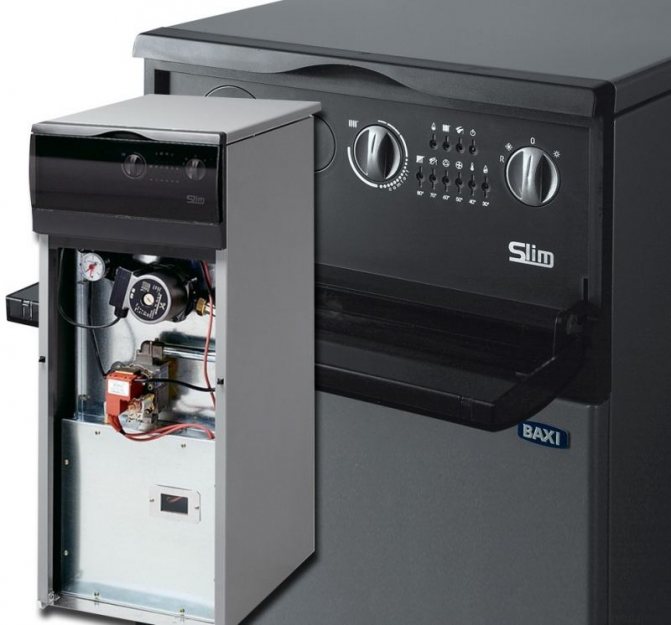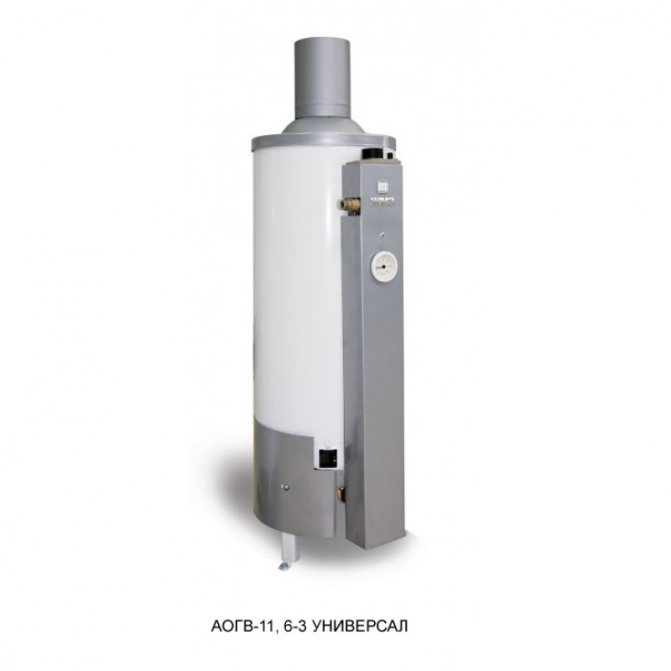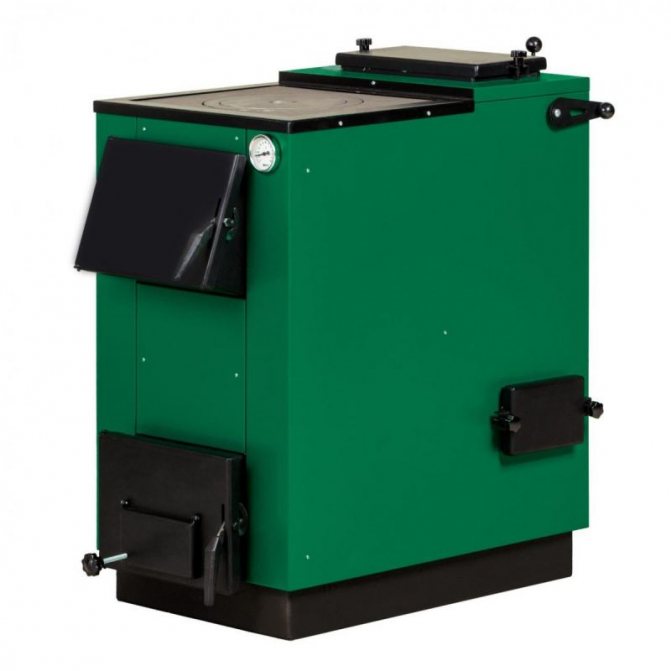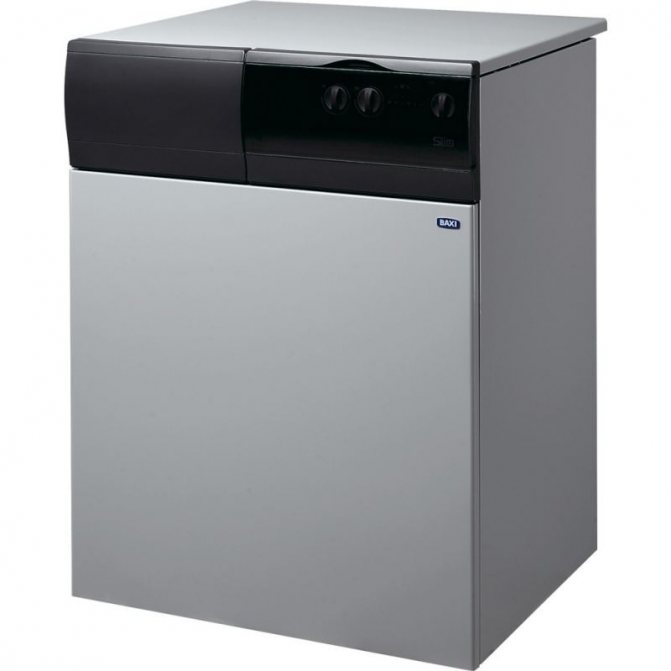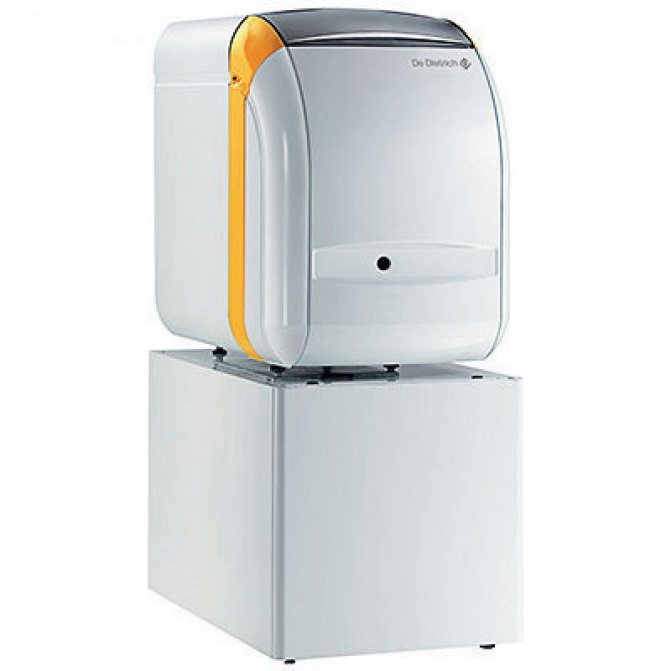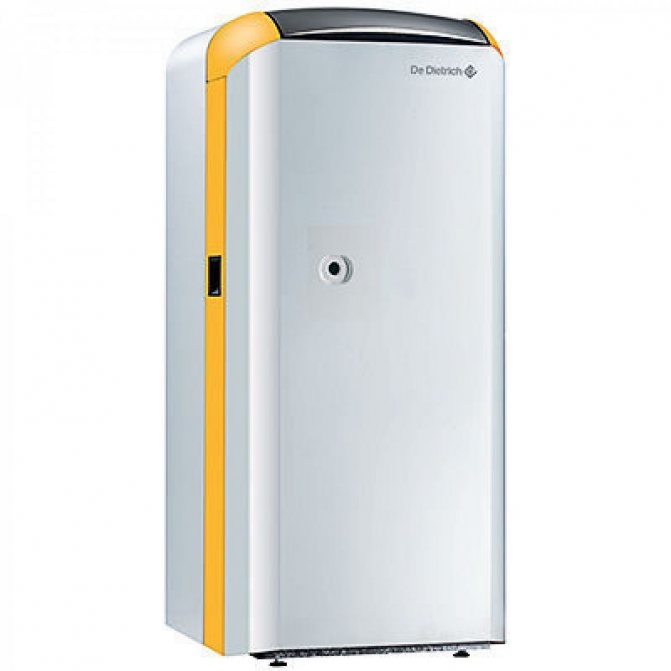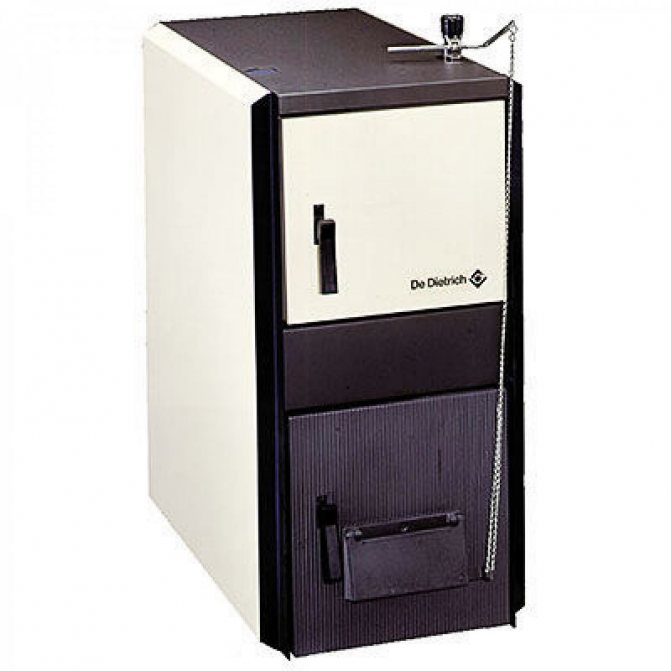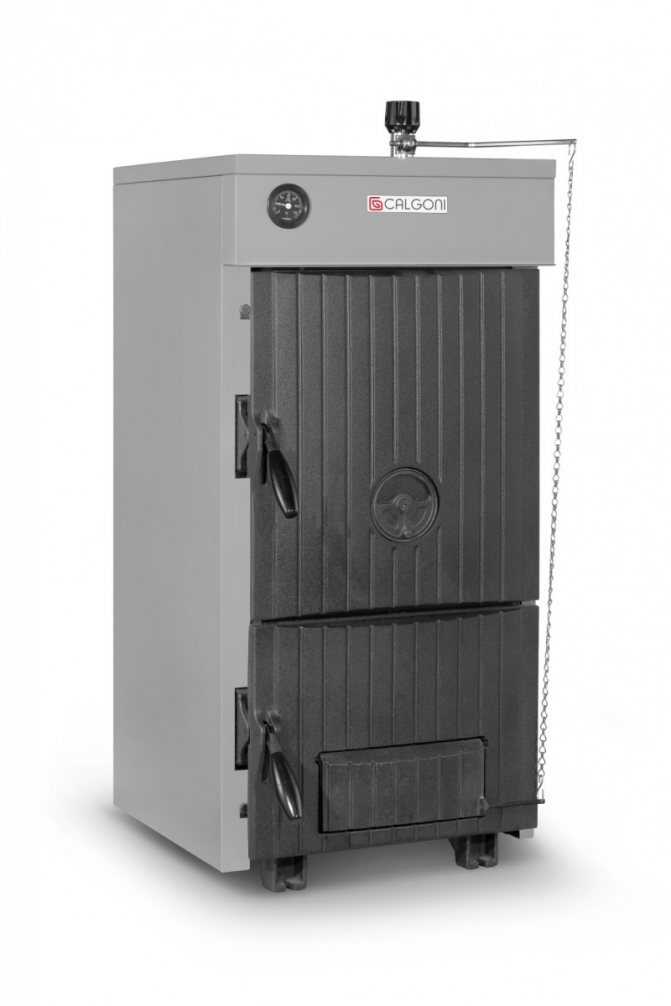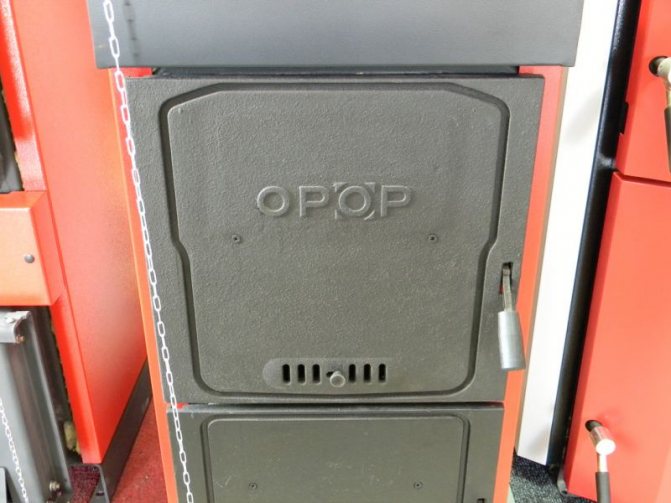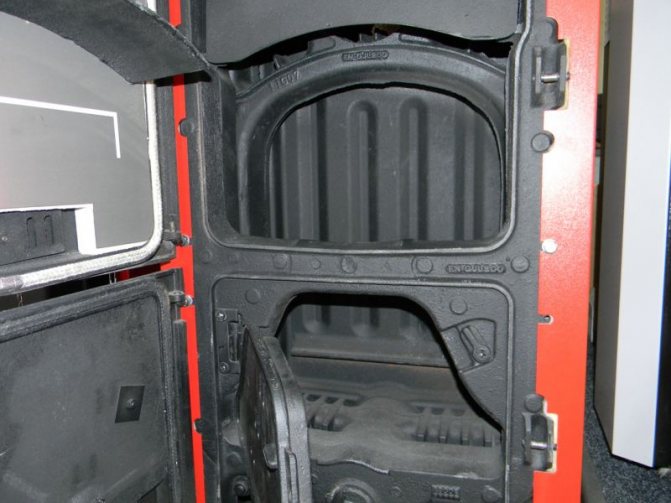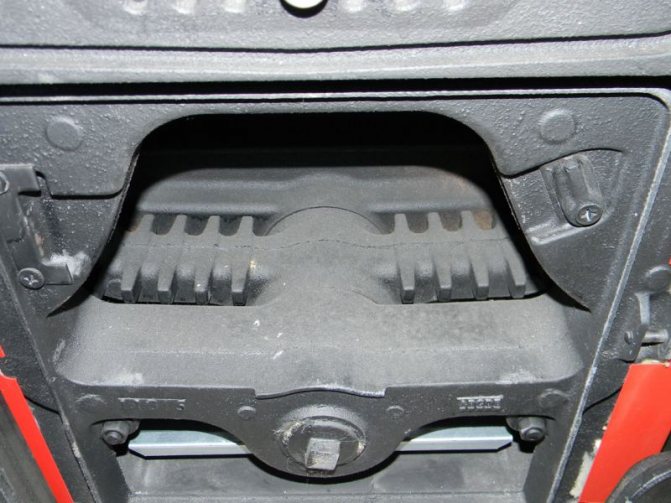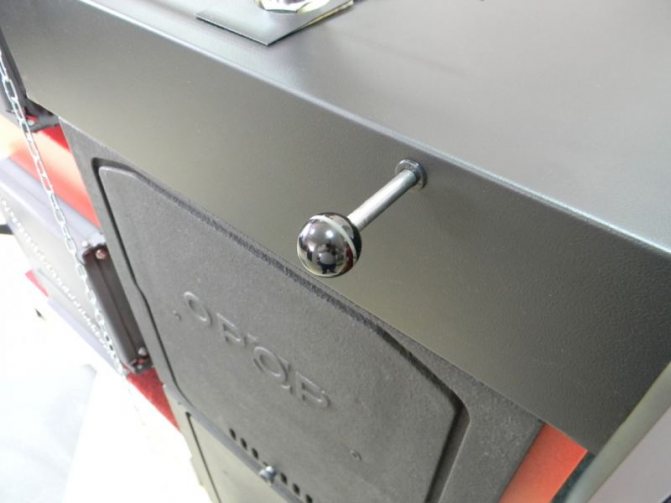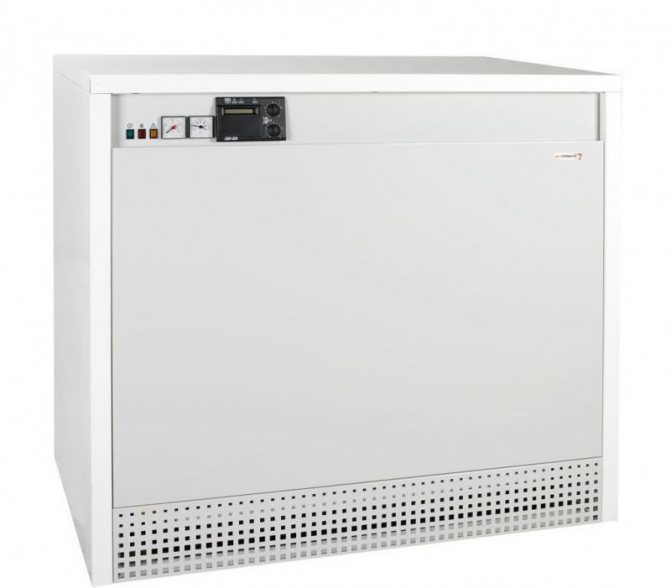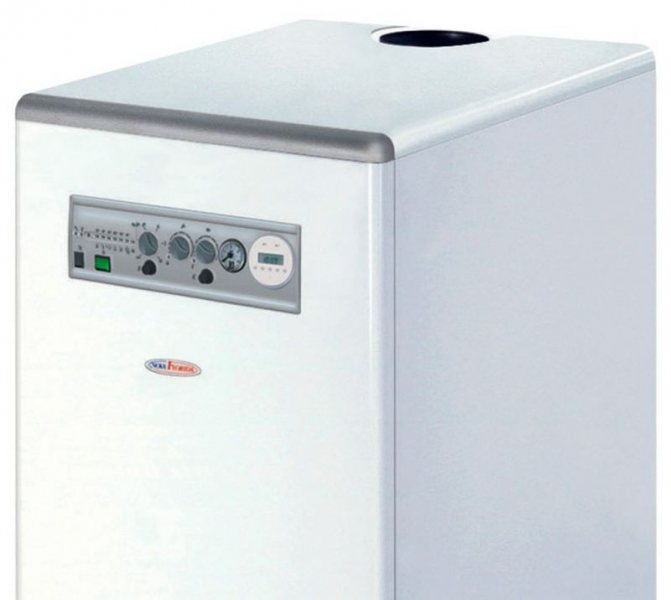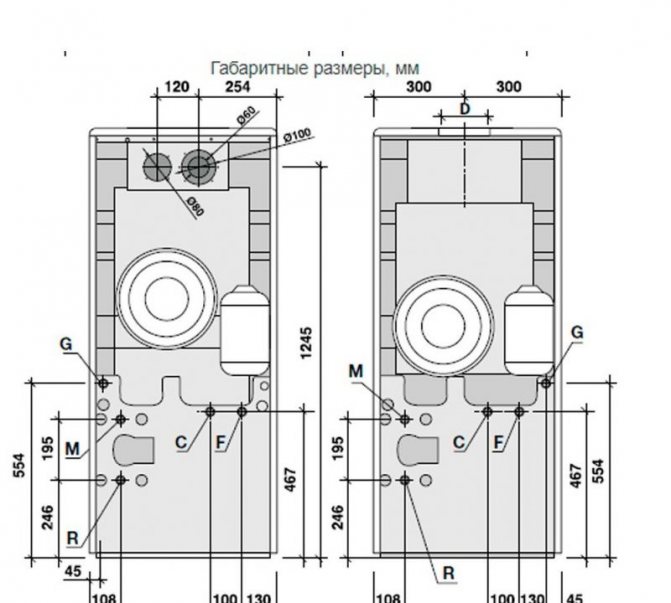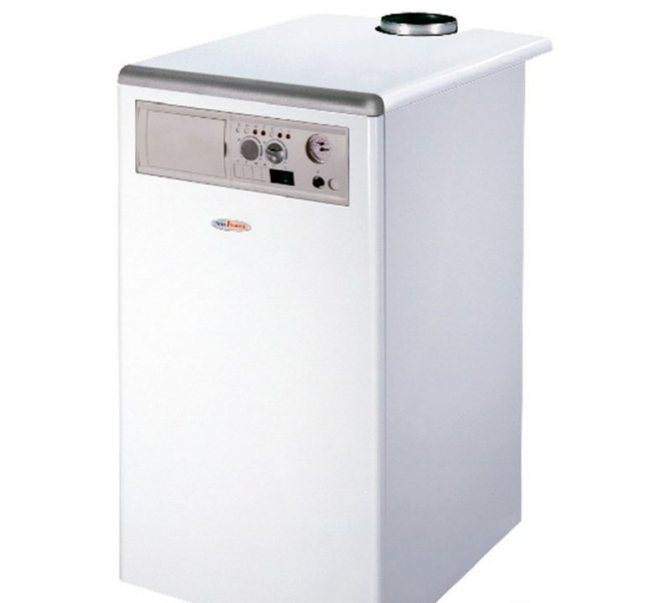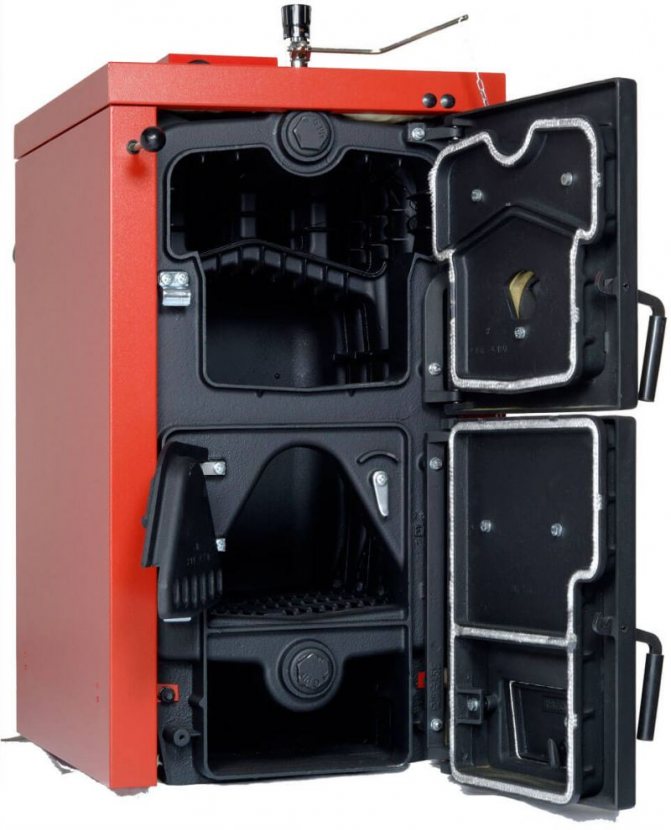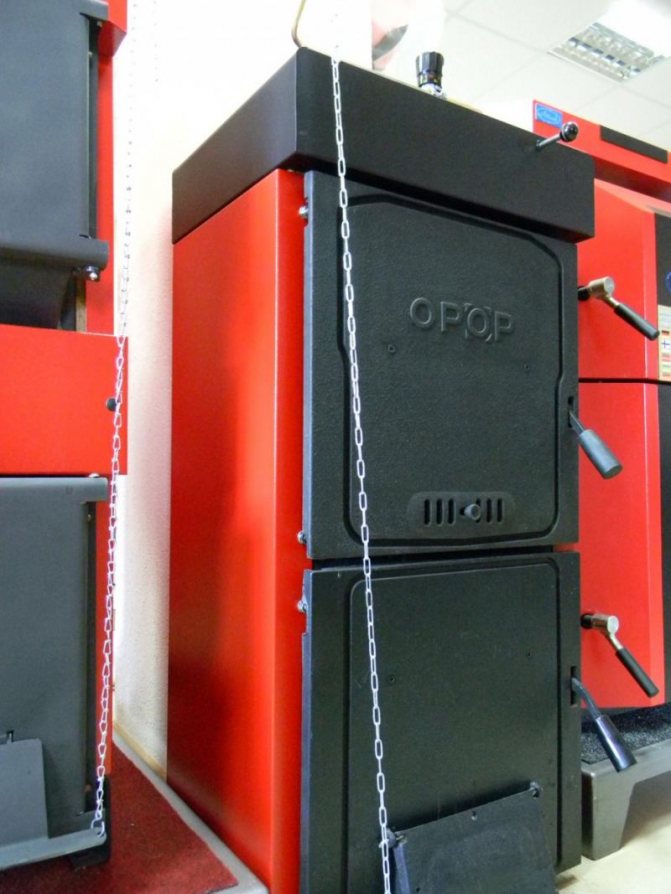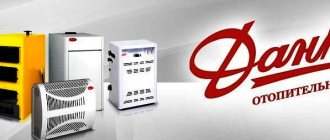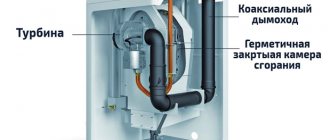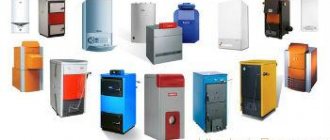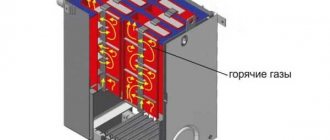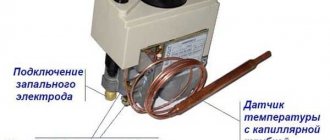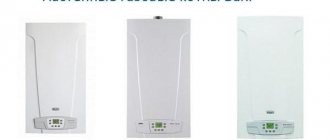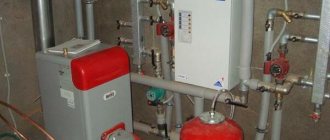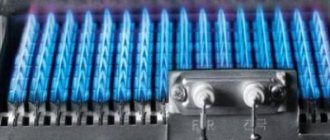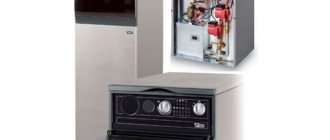Before the beginning of the winter season, many newly-made owners of private houses think about which boiler to choose so that the house is warm and cozy in cold weather.
For many owners of country houses that are heated with gas, the solution to this issue lies only in choosing a boiler that uses gas as the main type of fuel.
The equipment purchased must comply with the following principles:
- productivity;
- profitability;
- reliability;
- safety.
Cast iron gas boilers correspond to such characteristics, both according to the conclusions of experts and according to the statements of buyers.
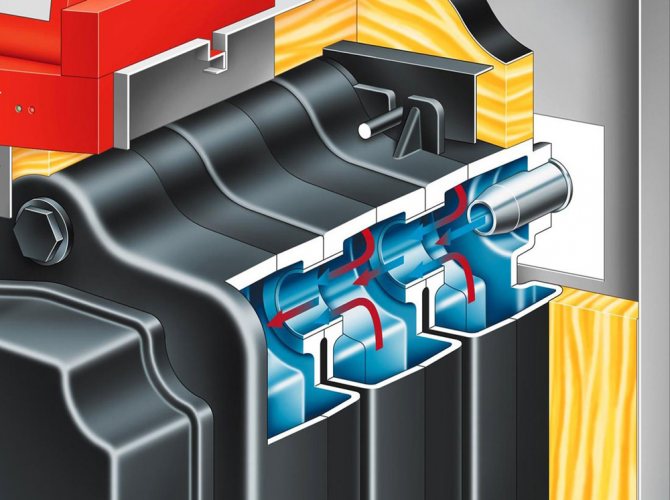
Features of cast iron boilers
For many decades, heating equipment made of cast iron has served and serves properly, since it was used mainly as a heating circuit. The popular use of cast iron is based on the fact that the material is very reliable and very durable.
A cast iron boiler fits into almost any thermal circuit, and it is designed so that the most common and cheapest heat carrier, namely water, runs inside it. And at the same time, cast iron, as a material, is able to withstand rather critical loads, namely:
- strong pressure drops in the circuit;
- drops that can accompany the fuel supply;
- incorrect draft in the chimney operation due to bad weather conditions.
A cast iron gas boiler in the assortment line of many manufacturers is sold with a good warranty period. This suggests that the manufacturer himself is confident in the durability of the product. For example, boilers made of steel are sold with a guarantee for a period of 12-14 years, and for the same boilers, but using cast iron instead of steel, a guarantee is given for 38-56 years. If the buyer wants to clarify the exact period for which the warranty applies, then it is necessary to decide on the manufacturer and model.
There are, of course, some points that affect the timing in which the boiler can work in any individual conditions:
- it is necessary to carry out an installation that meets all the correct standards;
- regular boiler maintenance by a technician;
- good compatibility with all components of the system.
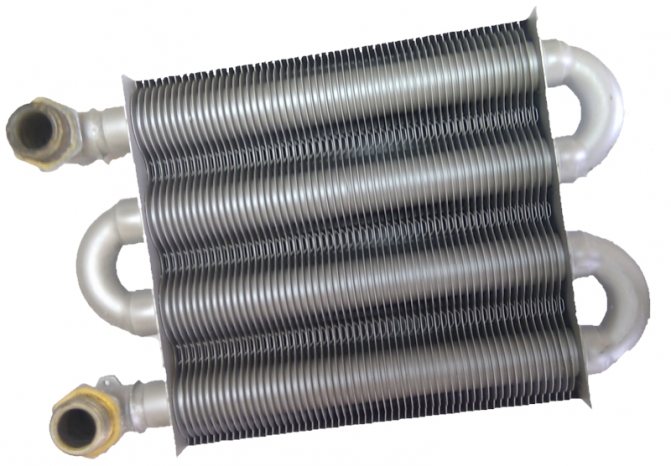

Reviews of standard gas floor boilers for home heating: advantages and disadvantages
If the purchase of a single-circuit gas boiler for floor placement is just ahead, then it is better to study the reviews of the owners of such equipment in advance.
Consumer qualities of floor-standing single-circuit gas boilers:
| Benefits | disadvantages |
| environmental friendliness - when burning, gas emits fewer harmful compounds than firewood, coal and various oil products | large dimensions - the installation of the boiler and the entire system (pipe outlet, taps, pump) requires a lot of free space |
| high performance - the power of household floor-standing boilers allows you to heat even large (up to 800 m2) houses | separate placement - the device is installed only in non-residential rooms (utility rooms, boiler rooms or bathrooms) |
| versatility of fuel - most units can consume both natural (methane) and liquefied (propane-butane) gas | the weight of the boiler - a large weight (up to 200 kg) greatly complicates transportation and increases the cost of installation services |
| boiler reliability - simple design, as well as a minimum set of automation guarantees protection against frequent breakdowns | the presence of a full-fledged chimney - it is responsible not only for the removal of combustion products, but also for the draft in the combustion chamber |
| a large selection of non-volatile models (not requiring connection to the mains) | usually simpler and less functional than wall-mounted automation |
Some users of floor standing boilers note that during severe frosts, their equipment ceases to function. This happens due to the fact that the pressure in the gas line decreases, the flame settles on the burner and the automation extinguishes it in order to prevent burning out. This feature is not a minus, just initially you need to choose a model that is more adapted to domestic conditions.
Specifications
Cast iron gas boilers are the most popular heating systems, which, according to their technical characteristics, are most suitable for using them in buildings intended for permanent residence.
The principle of operation of all cast iron gas-fired boilers is built like this: heat is released, which owes its appearance to the fact that the fuel is burned and the air heats up. In short, the next stage of work occurs, that is, when a fuel such as gas enters the combustion chamber, it burns out and gives all the heat to the coolant.
Then the coolant, which circulates through the system in a closed loop, is supplied to the batteries and the room heats up - the batteries begin to give off heat.
The technical characteristics of gas boilers with a cast iron heat exchanger differ in that:
- such a device does not require constant operation, since the heat exchanger keeps heat well, and the temperature sensor, capturing temperature fluctuations, does not perform manipulations that will start the boiler;
- one of the main parameters that dominates the technical characteristics is the durability of this type of material, even though the conditions can be extreme.
Working principle and main advantages
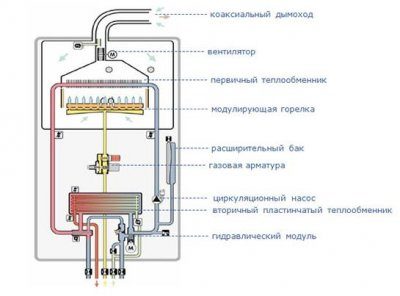

A double-circuit gas boiler works according to a simple principle. First, gas is supplied to the device, after which the ignition is switched on in it. After creating a spark, the igniter is ignited, which in turn ignites the burner. The burner heats the heating medium in the system until the set temperature level is reached.
The wall-mounted design of the boiler allows you to install it directly on the wall, or in a special niche in it. This arrangement makes it possible to save space and provide easy access to the boiler and its main control and regulation elements. A double-circuit boiler heats not only the coolant in the heating system, but also the water supplied for domestic and household needs. In this case, you do not need to connect any additional equipment.
Gas boilers can differ in the principle of ignition. So, depending on this moment, they are divided into two large groups:
- Models with electric ignition. Works automatically;
- Models with piezo ignition. To turn it on, you must press the corresponding button.
The type of ignition does not affect the boiler performance. This is purely a matter of ease of use. You just need to understand that electric ignition imposes a small price imprint on the boiler, slightly increasing its cost.
The wall-mounted gas boiler does not require constant intervention in the work. The whole process is controlled and regulated automatically, you just need to correctly configure the equipment.
The automatics set in a certain mode turns the device on and off. The control of the operating parameters is also carried out automatically. The system will not allow overheating or pressure increase, and will adjust the volume of fluid if necessary.
The gas burner heats up the heat exchanger through which the heating medium flows. With the help of a circulation pump, it moves further in the heating system.
Options for cast iron gas boilers
Cast iron gas boilers for heating a private house differ in the following parameters:
- Burners. By the type to which the burners themselves belong:
- atmospheric burners;
- either with fans;
- burners can also be used that use the principle of forced, that is, artificial, air pressurization, which causes the total pressure of all supplied fuel.
- They also differ in the type that is used in the installation of a thermal structure:
- floor;
- wall.
- By the way that is used when removing from residues and combustion products in the form of smoke. Turbocharged ones are used, but the availability of electricity is a prerequisite for use. Or chimney.
- General functionality: either those that work in one circuit, that is, they are able to heat only the room, or double-circuit ones, heating not only the room, but also water intended for various home use.
And also a gas cast iron heating boiler has at its core the main difference from analogs made of steel, it has a prefabricated and sectional design. The assembly of such a unit takes place exclusively by hand.
Also, the technical characteristics include the following points:
- heat engineering data are highly different from other materials - after the cast iron heats up, it gives off heat for a long time;
- quite persistently tolerates the effects of acids and corrosive environments;
- if any parts of the exchanger are damaged, then they can be easily replaced due to the fact that the structure is prefabricated;
- cast iron is able to withstand strong thermal shocks without deformation of surfaces, that is, it can withstand heating, which reaches 300 C. It is important to note: cast iron does not burn out;
- the minimum period in which a boiler can be used is about 25 years, but usually the service life of such boilers is about 35 years.
It will be interesting for you >> The principle of operation of a double-circuit boiler "Bosch"
Therefore, the user can quite calmly choose for himself exactly that version of the boiler that impresses him most in all its qualities.
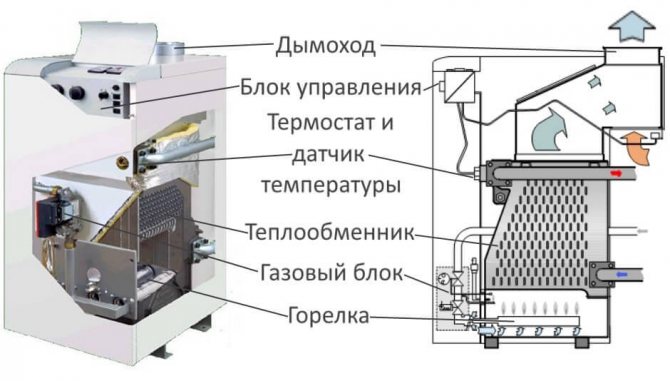

Steel or cast iron floor standing gas boiler
The parameter that must be determined when choosing a floor heating boiler is the material of the combustion chamber and heat exchangers. The most common are cast iron and steel.
The fiery heart of the unit
It is impossible to say unequivocally which of them is better, steel or cast iron. It is no coincidence that the main boiler manufacturers produce both cast iron and steel units. We can only talk about the technical and operational differences between these two types.
With an equal output power, cast iron units have a larger size and weight. The most important advantage, which is not without reason ascribed to cast-iron boilers, is their long service life. Such a heat exchanger is predicted to be 50 or more years old. Of course, this parameter primarily depends on the operating conditions of the boiler itself. In any case, 30 years is definitely not the limit. At the same time, steel heat exchangers serve an average of 20 years. However, at the same time, steel heat exchangers can be repaired, and in the event of a detected defect in cast iron, the entire section has to be changed. Of course, not only the material of the heat exchanger is decisive, but also the quality of the metal itself, its thickness and design.
Modern steel units are made of high-alloy heat-resistant steel, they are distinguished by their strength and greater corrosion resistance, which ultimately gives durability. Moreover, steel is more ductile than ordinary cast iron, therefore, the design of the furnace and heat exchangers made from it can be more complex and is considered more efficient in terms of heat transfer. However, the heat exchangers of modern floor standing boilers are made of special grades of "gray cast iron".This metal has improved ductility and increased structural homogeneity, which improves performance.
Steel boilers as such are less sensitive to thermal shock and mechanical damage during transportation or installation. However, if used improperly, the steel heat exchanger corrodes faster. Cast iron boilers have an advantage according to this criterion, cast iron is more resistant to corrosion than steel. Corrosion occurs when the boiler wall temperature is below the flue gas condensation temperature. To avoid corrosion, the temperature inside the boiler must be kept above the "dew point". Since this indicator is at the level of about 58 ° C, the temperature of the boiler walls must be at least 60 ° C. In principle, it is not very difficult to create normal operating conditions for the boiler. Previously, this was fought by maintaining a constantly high temperature in the circuits, which resulted in increased fuel consumption.
Considering that cast iron is still a brittle metal, cold water should not get into the uncooled heat exchanger, this leads to the formation of cracks. Today, this deficiency of cast iron is being dealt with quite successfully. In the first case, it is proposed to use the technology of low-temperature operation of boiler equipment, when the temperature of the return water for the boiler is not regulated. There are a lot of advantages here. The reliability and durability of the boiler increases, the efficiency increases, the fuel consumption and the amount of harmful emissions decrease, and the operating mode of the low-temperature "warm floor" system itself is the most comfortable for the inhabitants of the house.
The second option is the use of Thermostream technology. The essence of this technology consists in mixing cold water coming from the return line with warm water going to the supply line. Therefore, the coolant coming from the return line becomes warm before it reaches the surface of the heat exchanger. Thus, thermal shock of surfaces is completely excluded, even with a sudden flow of cold water from the return line. No additional measures are required to increase the return temperature or to maintain the minimum volumetric flow in certain operating modes. In continuous operation, the temperature on the heat exchange surfaces on the side of the combustion products is higher than the dew point temperature. Condensation does not form in the combustion chamber and on additional surfaces. Consequently, the likelihood of internal corrosion is also reduced. Thanks to Thermostream technology, the boiler is a fairly compact system with efficient heat exchange surfaces, which is reflected in an increase in the unit's capacity.
Start: Modern floor standing gas boiler
End: Floor-standing boiler and hot water in the house
The principle of operation of such a boiler
The principle of direct operation is similar to boilers made of other materials, or very slightly different. To ensure the operation of such installations, conventional standard assemblies are used.
The constituent parts of such a node are:
- burner;
- pump that circulates the coolant;
- combustion chamber;
- heat exchanger.
The boiler works because the supplied fuel, that is, gas, is burned in the combustion chamber, and all the heat is supplied to the coolant coil. In cast iron boilers, the main element is a cast iron coil, it is on it that the responsibility lies in ensuring that the coolant is evenly warmed up.
The positive principles of operation of cast iron gas boilers include:
- good corrosion resistance;
- undulating heat transfer;
- good adaptation to strong thermal overloads;
- long term of work;
- control service is close to a minimum.
But there are also disadvantages:
- significant weight;
- rather plastic, and therefore sensitive to loads that are produced mechanically;
- with critical thermal shocks, microcracks are formed.
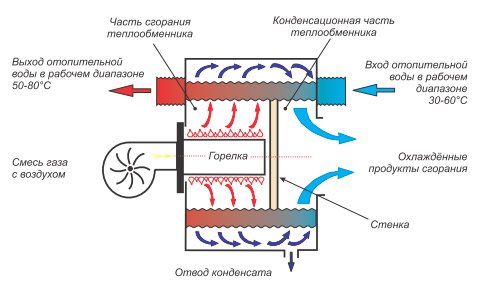

Other options
Above we talked about constructions of the accumulative type. That is, the water in the tank has a certain volume, which heats up. But there are also flow-through models on the market. In them, water is heated to a certain temperature as it moves through a special heat exchanger.
Usually the heat exchanger is made of a material with high thermal conductivity, good corrosion resistance. Therefore, this assembly is most often made of copper, aluminum or stainless steel. But their shape is a serpentine, because it is necessary to install a heat exchanger of a sufficiently long length in a small volume.
Simple wiring diagram
How to properly mount the equipment
You can install such equipment both independently and with the help of boiler installation specialists. The only condition that cannot be violated is to include the boiler in the gas system itself, because such work will have to be entrusted to a specialist. Moreover, such people must have special approvals and certificates. If the homeowner violates this provision, then first of all, he will be disconnected from the system, and secondly, a very large monetary fine will be imposed. But in order to independently connect a cast-iron gas boiler, you still need construction skills.
Cast iron boilers have an impressive weight, so if a hinged boiler is bought, then an impressive frame must be mounted under it. It is necessary to install such equipment in a boiler room.
And there are special requirements for such a technical room:
- the ceiling height in the boiler room must be at least 3 meters, and the room must be at least 4 sq. meters. These parameters are suitable for a boiler with an average capacity, but the larger the boiler, the more it should be around the place. Usually such things are recommended by the manufacturer themselves;
- the presence of at least a single window, because there must be an air flow. The opening for the door must be 80 cm wide and the gap between the floor and the door leaf must be at least 35 mm;
- there must be a distance of at least 3.5 meters to electrical and gas installations or appliances;
- on the floor, in the place where the installation of the cast-iron boiler is planned, a cement screed is poured, and this place is reinforced with a steel plate. It is important to remember that the steel sheet must be located under the entire bottom surface of the heating installation, and also protrude 3-4 cm beyond on its front side;
- materials with refractory qualities, it is necessary to strengthen the entire part of the wall where the chimney pipe will pass.
You will be interested >> The principle of operation of a double-circuit gas boiler Ariston
The main paper for self-preparation of the boiler for mounting it into the system should be an accompanying document in the form of instructions developed by the manufacturer.
Such a document gives the parameters and regulates the procedure for how the boiler can be connected to the main pipeline, to the chimney system, as well as the return and supply system.
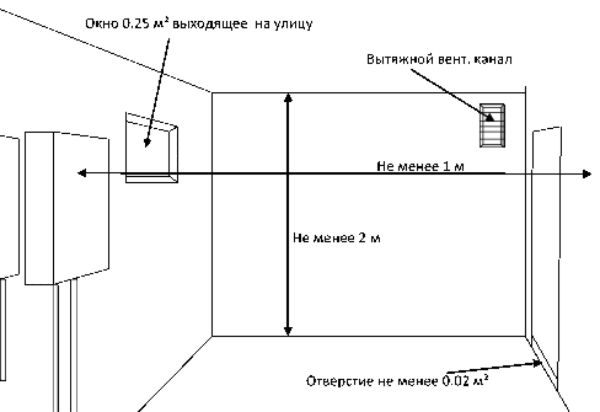

Installation of equipment
On sale are cast iron floor gas boilers, the installation of which is carried out after pouring a concrete cushion or building a foundation made of heat-resistant bricks. There are no wall-mounted models on sale, since the large weight of the cast-iron heat exchanger affects the dimensions and weight of the case itself. When installing cast iron gas boilers in the house, property owners must be guided by the instructions of the heating scheme.
It is this document that regulates the procedure for connecting the boiler to the supply and return pipelines, as well as to the main pipeline and the chimney system. It is important for the owner to choose the right place for mounting the device in the house. The room should have a certain area and volume, as well as provide an acceptable level of natural ventilation.
Choice of coolant
For cast iron gas boilers, mainly, such heat carriers are used as:
- distilled water;
- antifreeze.
According to its characteristics, cast iron cannot enter into any reaction with a liquid that does not freeze. The sections of the device are mounted so tightly that leaks are excluded even after antifreeze has been introduced into the system.
The user, when choosing the medium that will circulate along the contour, should be guided by the following characteristics:
- by heating time - in this case, water has a lower density than antifreeze. Therefore, the water warms up faster. In terms of time, warming up occurs from 15 to 40 minutes. It all depends on the quality of the coolant;
- but non-freezing gives off heat much longer, because in terms of its physical qualities it cools down more slowly than water.
Therefore, the heat carrier is selected on the basis of the principle for which the heating system will serve in the future, for permanent operation or for temporary heating of premises.
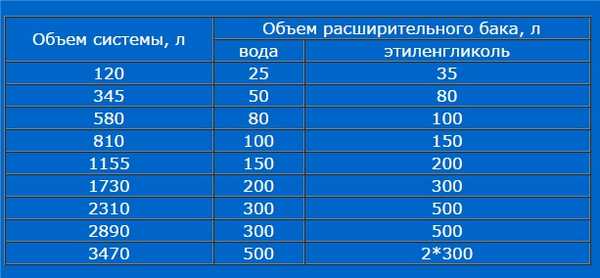

Differences from other types of boiler equipment
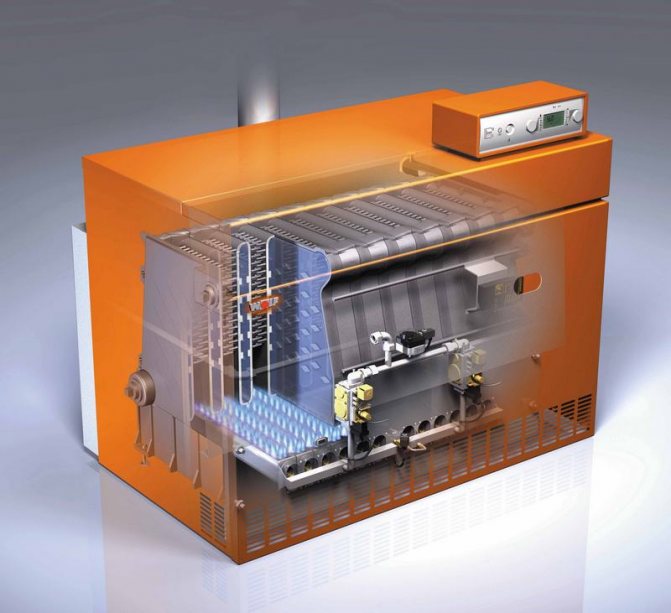

Modern floor-standing gas appliances have their own design features that allow achieving a high level of efficiency. First of all, it is the high height of the combustion chamber, which makes it possible to achieve the necessary thrust for the combustion of gaseous fuel.
Manufacturers managed to get away from the heavy weight of such devices. Today it is about 190 kg, which allows them to be installed in almost any room and does not require special equipment.
This made it possible to reduce the cost of the entire heating project and made floor standing boilers even more popular. They have a peculiarity - they can work equally well not only on gas fuel, but also on diesel. To do this, you just need to change the burner to a modulating one.
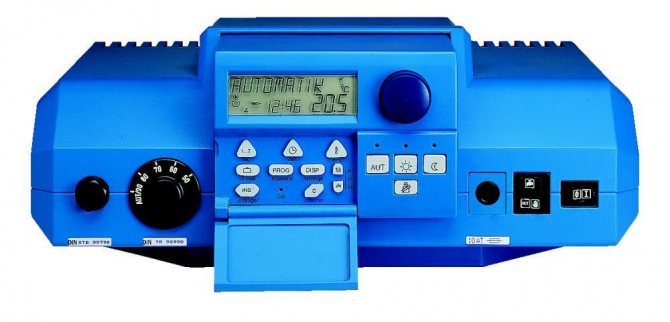

The range of devices has undergone major changes lately. Now their complete set very often includes:
- expansion tank
- pump
- water heater
Models with a closed combustion chamber have become commonplace.
What are the features during the operation of such a boiler
Usually, during operation, there are few problems with cast iron boilers. But still, there are some features, the observance of which will prolong the life of the unit:
- in half of the cases, the reasons for the need to change the boiler much earlier than the due date are mechanically caused damage to the device during its transportation. Cast iron is quite fragile and ductile, so if the boiler is dropped or hit in any way during transportation, the heat exchanger may fail. Therefore, when the boiler arrives at the site, it is necessary to pour liquid into the coolant to make sure that there is no leakage;
- sharp temperature jumps over time can lead to the formation of microcracks, therefore, it is necessary to add a mixing unit to the system during installation;
- a prerequisite for good operation is competent site preparation.
If the user handles the heating system carefully, then the installation can last much longer than the manufacturer planned.
Device and principle of operation
Simple non-volatile gas boilers have an easy control function, albeit inflexible. All required protective functions are based on a mechanical principle of operation. In modern such modifications, full functionality is implemented, similar to volatile devices. The functioning of the automation of gas double-circuit floor units, for example, Viessmannwolf and Lemax, is supported by the use of thermal energy: gas fuel burns, the released heat feeds a thermocouple, which converts heat into electricity, which is sufficient for the operation of automation systems.However, this amount of energy is not enough to power the heating medium circulation pump, therefore such boilers can only be operated in systems with a natural movement of heating water.
Non-volatile boilers are produced in both single-circuit and double-circuit versions, with additional DHW load. In most cases, these are floor standing models.
The principle of operation of double-circuit floor non-volatile heaters:
- Gas combustion is carried out by an igniter after the basic burner has been ignited.
- The igniter is started by holding down the operating button, then the main burner is turned on, providing gas combustion and heating hot water in the heat exchanger.
- When the temperature regime in the heating circuit, set by a mechanical thermostat, is reached, the fuel supply to the burner stops, the base burner turns off, while the igniter burns continuously.
- After the temperature drops below the set value, the current generated by the thermocouple is fed to the electromagnet, held by the gas supply and gives a signal to open the gas, after which the boiler continues heating the room.
- When the mixer is opened for hot water, the ball valve redirects the heat carrier flow to the DHW circuit, after closing the tap, the heating water returns to the heating circuit.
What principles should be followed when choosing a boiler
When choosing a boiler, a person, first of all, should be guided by the advantages or disadvantages of a particular model. Therefore, it is worth taking a closer look at what advantages or disadvantages cast-iron gas boilers have:
- at a cost, cast iron heating devices are much more expensive than the same units made of steel. But such a cost is justified by the fact that a cast-iron apparatus will last 15 years longer than a steel one;
- if a steel heat exchanger breaks down in a steel boiler, then any technical part cannot be repaired, because it is impossible to seal the seams by welding. But the cast-iron unit is repaired quite easily, because it is assembled in sections and you can replace any of the component parts;
- if the user has certain skills in welding, then it is quite easy to repair the boiler on his own, as well as increase the volume of the existing cast iron boiler by connecting sections;
- cast iron is difficult to corrode, and is also inert to the effects of any acids, so any antifreeze can be safely poured into the circuit;
- cast iron is much better in thermal performance than steel.
There are not very many disadvantages of such heating systems:
- high cost, due to the fact that cast iron is more expensive than steel, but this is covered by a long service life;
- large weight, it is quite difficult to install such a boiler alone;
- obligatory pouring of the plate under the boiler itself.
Despite the fact that cast iron boilers are less popular than steel ones, the homeowner should still think about what to do better. Win an insignificant amount on the difference in the cost of boilers at once, or still buy yourself a good unit so that it will serve for many years and also help save on fuel.
Hinged single-circuit and double-circuit boilers: differences and features
Hinged gas boilers can have a second heating circuit for preparing hot water. Such models are called double-circuit and have a number of design features:
- in the DHW mode, the water heated above the burner is cut off by an automatic three-way valve from the heating main and supplied to the heat exchanger of the second circuit, where it transfers energy to the running water from the water supply;
- in hinged double-circuit gas boilers, a larger number of units are used, which reduces reliability and increases the cost of the boiler
- the DHW circuit capacity rarely exceeds 10 l / min.This amount of hot water is quite enough for only one or two consumers. Such a device is no longer capable of providing a simultaneous consumption of hot water in the kitchen, in a washbasin for a bath set.
Read more: Plaster for plasterboard what plaster to choose for plasterboard
Wall-mounted gas boilers will successfully cope with heating a room if they are used in a given range. In order to choose the right heating device, one should take into account not only its technical characteristics, device and principle of operation. It is also worth paying attention to the positive and negative properties of the equipment.
Benefits
- ease of installation;
- low cost of fuel;
- reliability;
- no need for additional care;
- the ability to maintain a comfortable temperature at any time of the year;
- compactness;
- ergonomic design.
disadvantages
As a rule, household wall-mounted gas boilers are not very powerful, therefore they are not suitable for heating large mansions. Another negative factor concerns devices of the double-circuit type, equipped with a three-way valve. If it is necessary to use hot water, the heating of the coolant stops. If the hot water is turned on for a long time, the system may cool down.
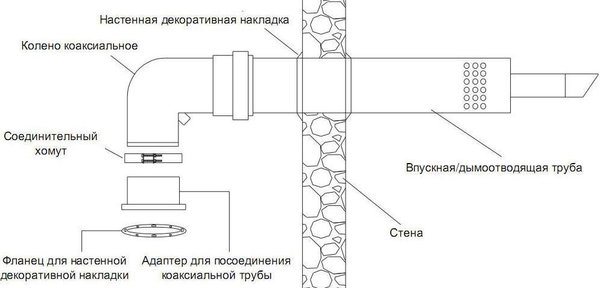

The heat exchanger of the boiler, especially if it is made of steel, is sensitive to chemicals in the coolant and is susceptible to corrosion. To avoid its premature failure, a softening filter should be installed or after the heating season the heat exchanger should be cleaned of accumulated salts.

